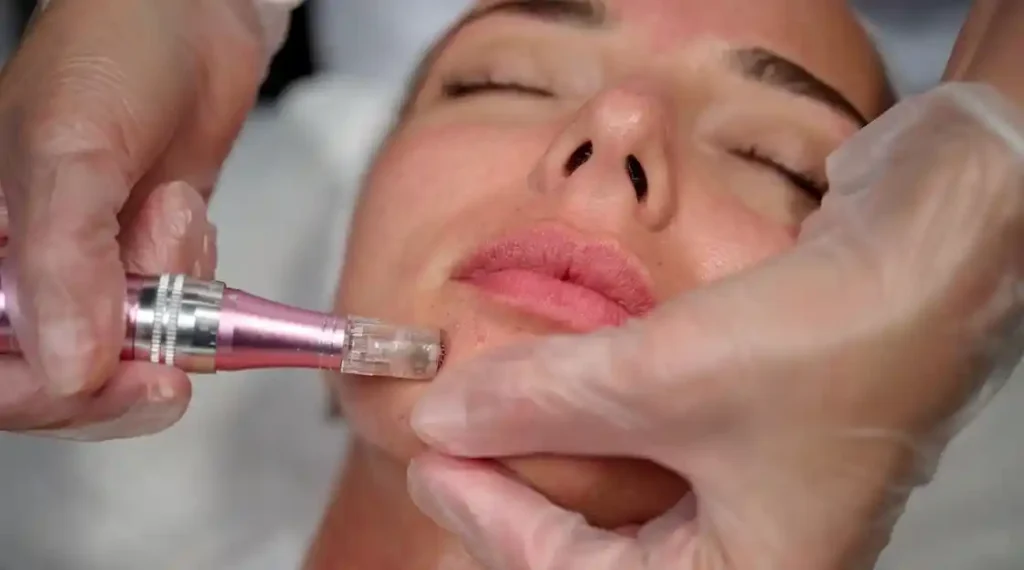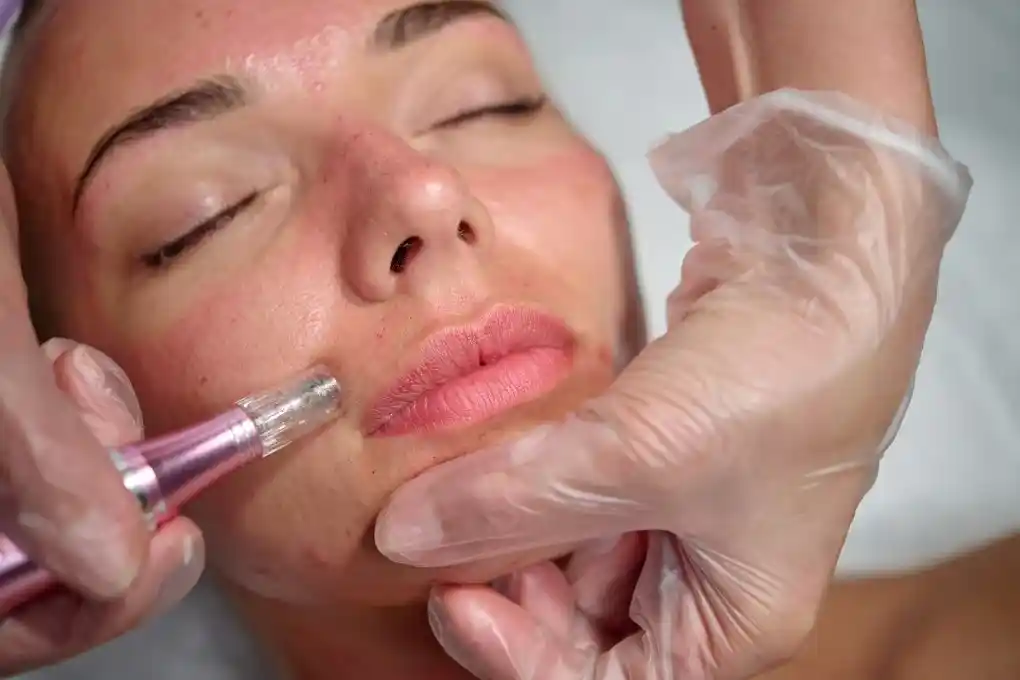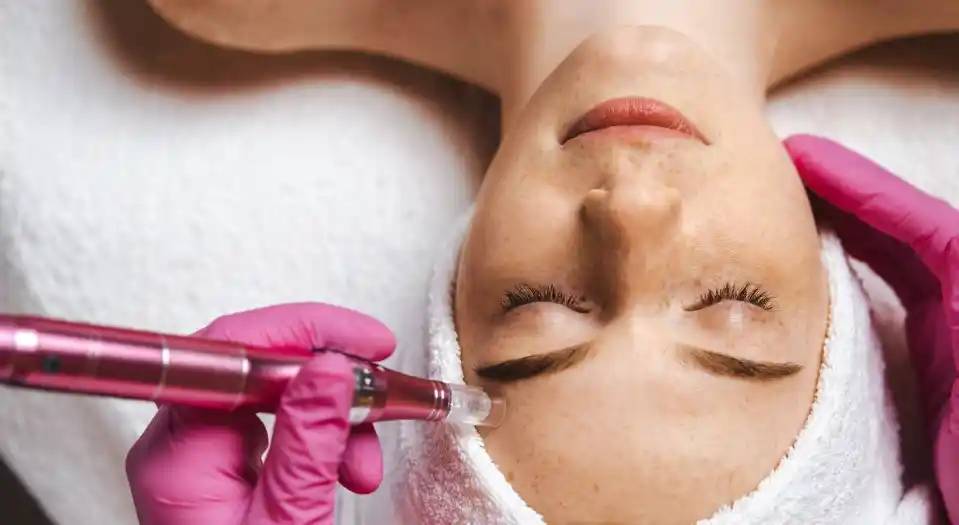Microneedling has become one of the most popular cosmetic treatments for attaining smoother, younger-looking skin. The need for this collagen-enhancing therapy is growing all over the world as more individuals find out its natural rejuvenating effects.
As a matter of fact, the microneedling sector is likely to experience robust growth by 2033, with studies indicating it will surpass $1.3 billion. This fast rise shows the increasing confidence in non-invasive treatments that elevate skin health with minimal downtime.
Also known as collagen induction therapy, microneedling develops controlled micro-injuries in the skin to stimulate collagen and elastin production. However, there is one common question that is present in the minds of a huge number of patients:
“How often should you microneedle?”
The answer depends on your skin type, age, and the particular issues you want to target. Let’s examine how this treatment works and how often can you do microneedling for more effective results.
What Is Microneedling?
Microneedling is a moderately invasive cosmetic procedure that refreshes the skin by activating its natural healing procedure. Utilizing a device equipped with sterilized micro-needles, small punctures are crafted on the skin’s surface. These micro-channels signal the body to generate new collagen and elastin, resulting in a radiant complexion.
As per the American Academy of Dermatology Association (AAD), the body’s healing response following microneedling aids in decreasing the following while enhancing skin elasticity:
- Scars
- Fine Lines
- Dark Spots
A few studies also suggest that it can support hair growth in individuals with alopecia, making it a universal treatment for both skin and scalp health.
How Microneedling Works
The first step in the procedure is the cleansing and numbing of the treatment area. After that, a handheld device having extremely fine, sterilized needles is rolled or pressed into the skin, crafting controlled micro-injuries. These minor punctures trigger the body’s natural repair mechanisms.
The following activities take place during the procedure:
- Micro-lesions are produced. These are small, controlled injuries in the upper layer of the skin.
- The body reacts immediately, transferring signals to generate new collagen and elastin.
- Healing starts, and over time, the skin becomes thicker and more resilient.
First implemented in 1996 by Dr. Des Fernandes, microneedling was initially used as a medical tool to improve collagen production. At present, it is a common and secure treatment used by dermatologists and aestheticians all over the globe.

Understanding Collagen Induction Therapy (CIT)
Collagen Induction Therapy (CIT) is a microneedling procedure that stimulates collagen production. Devices like Morpheus8 combine microneedling with radiofrequency energy, further stimulating tissue remodeling and regeneration. The treatment reinforces the skin’s structure by stimulating the formation of new collagen and elastin, enhancing the following:
- Texture
- Tone
- Firmness
Stages of Skin Renewal
The following are three different phases of skin renewal:
Inflammation
Instantly after microneedling, the body transmits immune cells to the treated area to avoid infection and clear trash. This response enhances blood flow, delivering oxygen and nutrients mandatory for repair. The inflammation stage also activates major growth factors that start collagen production.
Proliferation
During this phase, fibroblasts, the cells responsible for generating collagen and elastin, become extremely active. New skin cells form, blood vessels develop, and the dermal structure starts to improve. This stage elevates the skin barrier and forms a streamlined surface.
Remodeling
The last phase focuses on fine-tuning and reorganizing collagen fibers. The skin becomes more elastic and visibly rejuvenated as new, healthy collagen replaces previous tissue. This procedure lasts for several weeks, meaning results improve steadily over time.
Advantages of Microneedling
Microneedling is recognized for its capability to tackle a broad spectrum of skin issues with minor discomfort and downtime. The process can be customized to individual skin requirements, providing several advantages such as:
- Decreased Appearance of Acne Scars and Fine Lines: By stimulating collagen production, microneedling aids in streamlining acne scars and lessening fine lines, fostering a youthful appearance. It also elevates the efficiency of topical acne treatments by enabling greater absorption.
- Enhancement in Wrinkles and Enlarged Pores: Small, controlled micro-injuries start the creation of collagen and elastin, aiding in decreasing wrinkles, crow’s feet, and fine lines. Enhanced collagen also tightens skin, fine-tuning the look of enlarged pores.
- More Even Skin Tone and Increased Elasticity: Microneedling may enhance hyperpigmentation, decrease redness, and improve general skin elasticity. For conditions such as rosacea, it helps calm hypersensitive blood vessels, leading to a steadier tone.
- Diminished Hyperpigmentation or Dark Spots: Sun damage and age spots are general concerns. Collagen induction therapy restores skin texture while decreasing discoloration, providing the skin with a vibrant appearance.
- Reduced Stretch Marks: By stimulating elastin and collagen formation, microneedling may decrease the visibility of stretch marks, making them less evident over various sessions.
- Supports Other Skincare Treatments: Micro-channels developed during microneedling elevate the absorption and efficacy of topical products. It does not matter whether they are anti-aging serums, acne medications, or moisturizers, as they all deliver active ingredients deeper into the dermis.
Compared with laser therapy, microneedling is particularly preferred for darker skin tones, as it does not rely on heat, which may cause pigmentation issues. It is a secure and economical option for various skin types, delivering in-depth rejuvenation.
What Happens During a Microneedling Session
Your skincare expert will decide the correct needle depth based on your skin condition and objectives. The device normally penetrates 0.5-3.5 mm into the skin. The process includes numerous passes over the same area in various directions to guarantee uniform coverage.
Once finished, the treated skin might show light redness or pinpoint bleeding, a normal sign that collagen stimulation has started. In the next few days, the skin begins to heal, showing a fine texture and a more even tone.

Factors That Impact Microneedling Frequency
The desired frequency for microneedling varies from person to person. Numerous factors determine the answer to this question: “How often should you do microneedling?”
Let’s have a look at the factors impacting microneedling frequency:
- Skin Type: Sensitive or dry skin types require more time to recover, so sessions must be placed further apart. Thicker or more resilient skin might stand brief intervals.
- Depth of Skin Concerns: Mild issues, such as uneven tone or texture, need fewer sessions, spaced 4-6 weeks apart. Bigger problems, like scars or wrinkles, require more frequent treatments to support long-term collagen buildup.
- Age: Younger skin regenerates quickly and might require fewer sessions. Older skin, which takes longer to heal, benefits from slightly closer scheduling to improve collagen stimulation.
- General Skin Health: Healthy skin recovers quickly and responds more effectively to treatment. If you have conditions such as eczema, active acne, or a compromised skin barrier, it is better to tackle those first.
- Lifestyle Choices: Extreme sun exposure, smoking, and stress may delay healing. Maintaining a healthy eating plan, staying hydrated, and a consistent skincare routine can help you achieve better results with fewer treatments.
How Often Should You Microneedle?
The frequency of any individual’s microneedling sessions depends on the condition they are targeting. As a general rule, most individuals benefit from treatments every 4 to 6 weeks. Nevertheless, the intervals differ based on particular skin problems, such as:
- Fine lines & Wrinkles: Every 6 weeks
- Sun damage: Every 2-4 weeks
- Pigmentation: Every 2-4 weeks
- Acne: Every 4 weeks
- Scarring: Every 6 weeks
For slight skin improvements, a couple of sessions can be sufficient. More critical issues, such as deep acne scars or stretch marks, may need 4-8 treatments for the best possible results. Your skincare professional will evaluate your skin’s progress and personalize a treatment plan according to that.
Signs That You’re Microneedling Too Often
Although microneedling is designed to rejuvenate your skin, it is significant to give it sufficient recovery time between sessions.. Overdoing it may actually delay healing and trouble your skin rather than enhancing it.
The following are a few of the signs that indicate that you may be microneedling very often:
- Persistent Redness: Light redness is likely to persist for 1 to 2 days. However, if it lasts far longer than that, your skin might be having difficulty recovering.
- Lingering Irritation: Continuous itchiness or discomfort may indicate the skin barrier has not fully healed before your next session.
- Extended Swelling: Mild swelling must fade swiftly. If it persists for several days, your skin likely needs more downtime.
- Increased Sensitivity: Stinging or discomfort during everyday routines or with temperature changes might indicate damaged skin.
- Dryness or Peeling: Extreme microneedling may compromise your skin’s natural moisture barrier, resulting in flakiness and dehydration.
- Breakouts or Inflammation: When the skin does not have sufficient recovery time, it may become more susceptible to irritation, acne, or infection.
- Unusual Reactions: Any worsening of your skin’s condition or unpredictable reactions are clear signs to stop and consult your skincare specialist.
Optimal Time Between Sessions
Giving your skin sufficient time to heal is necessary. The general suggestion is to wait at least 4-6 weeks between treatments. This guarantees that collagen production has enough time to develop correctly before the next session.
Always follow your practitioner’s suggestion, as they will customize your schedule to optimize results and reduce irritation.

At-Home vs. Professional Microneedling
There is a lot of debate between at-home microneedling and professional microneedling. Let’s briefly examine both:
At-Home Microneedling
With the rise of at-home skincare tools, microneedling kits are now attainable for personal use. Even though they are convenient, they come with particular limitations.
Pros
- Can be performed anytime from home.
- Aids with small skin texture or tone problems.
Cons
- There is a greater risk of infection if tools are not sterilized correctly.
- Needles are shorter, so penetration is restricted.
- Not efficient for deep wrinkles or scars.
- An incorrect method might result in irritation or injury.
At-home treatments are more appropriate for surface-level maintenance but cannot replace expert accuracy and safety.
Professional Microneedling
Professional microneedling offers more long-term results. Dermatologists and certified aestheticians use medical-grade devices that penetrate deeper layers of the skin, fostering powerful collagen production.
Advantages
- Deeper Skin Penetration: Perfect for scars, pigmentation, and fine lines.
- Professional Supervision: Decreases risk of infection or side effects.
- Personalized Approach: Treatments are customized to your particular skin requirements.
- Lasting Benefits: Continued collagen production enhances skin health over time.
Apart from the above-mentioned advantages, you will also get a clear idea of how many microneedling sessions you actually need.
Maximizing and Retaining Microneedling Results
To make the most of microneedling, proper pre- and post-care are mandatory.
Before Treatment
- Consult Your Expert: Show any skin conditions or infections.
- Stop Topical Medications: Abstain from retinoids and Vitamin A creams at least 5 days before treatment.
- Avoid Blood Thinners: Stop aspirin, fish oil, or the same medications after consulting your physician.
- Skip Anti-Inflammatory Drugs: Prevent ibuprofen or Advil for a few days before and after treatment to enable natural inflammation.
- Exfoliate Gently: Light exfoliation a few days before treatment helps remove dead skin cells (not the night before).
After Treatment
- Keep Skin Hydrated: Use soothing products such as hyaluronic acid.
- Avoid Harsh Ingredients: Stop using exfoliants, acids, or retinoids for numerous days.
- Protect from Sun Exposure: Always use sunscreen to prevent pigmentation.
- Remain Makeup-Free: Give your skin 24-48 hours to recover before implementing makeup.
Common Mistakes To Avoid for Best Microneedling Results
Regardless of an excellent treatment plan, specific aftercare mistakes can decrease the performance of your microneedling results. To safeguard your skin and retain that post-treatment glow, refrain from the following mistakes:
- Skipping Sunscreen: Exposure to UV rays may diminish the collagen-enhancing benefits and result in unwanted pigmentation.
- Using Harsh Products: Avoid retinol, exfoliants, or other strong actives for a couple of days to avoid irritation.
- Touching Your Face: Post-treatment skin is sensitive. So keep your hands off to avoid introducing bacteria or causing inflammation.
- Neglecting Aftercare Instructions: Always follow your provider’s suggestions to support optimum healing and collagen renewal.
- Bad Habits: Excessive smoking or drinking may slow collagen creation and delay skin recovery.

Combining Microneedling with Chemical Peels
Microneedling can also be combined with chemical peels for ideal results. They are generally spaced two weeks apart, but in a few cases, can be conducted together to improve skin renewal.
Mutual Advantages
- Better collagen stimulation.
- Enhanced texture and tone.
- More in-depth rejuvenation of the skin.
This dual approach addresses both surface imperfections and deeper layers, providing comprehensive enhancement in skin quality.
Long Story Short
Microneedling is among the most efficient non-surgical treatments for refreshing the skin. So the answer to the most frequently asked question, “How often should you microneedle,” depends on your skin type, age, and concerns. However, consistency and adequate care are mandatory for long-term results.
Rely on a registered expert to decide your perfect schedule and guide your aftercare routine for the optimal result. At Arynova Aesthetics, we are committed to aiding you in attaining radiant, youthful skin with state-of-the-art microneedling methods customized to your requirements.
For more information, feel free to contact our crew anytime by dialling (847) 654-7274!
Frequently Asked Questions
How frequently should you microneedle at home?
At-home microneedling is best performed every 2-4 weeks with short needles (0.25–0.5 mm). Those with sensitive skin must wait 6-8 weeks between sessions to enable complete healing and avoid irritation.
Can you do too much microneedling?
Yes. However, keep in mind that extreme microneedling or too little recovery time may result in the following:
- Redness
- Irritation
- Inflammation
- Hyperpigmentation or Scarring
It is highly recommended to give your skin sufficient time to repair between sessions.
Is microneedling good for psoriasis?
Microneedling is generally not recommended for psoriasis, as it can activate the Koebner phenomenon, in which new lesions form on injured skin. It might also cause flare-ups in treated areas, so expert advice is mandatory.
Does microneedling help rosacea?
Gentle, adeptly executed microneedling can benefit mild rosacea by refining texture and decreasing visible pores. Nevertheless, it should be performed with caution to prevent aggravating sensitive skin.
How many microneedling sessions are generally needed for the best results?
Most individuals require 4-8 microneedling sessions, with approximately 4-6 weeks between each. The precise number depends on your skin type and age.

